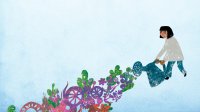3 Ways to Boost Student Well-Being and Lower Stress
How a sixth-grade teacher promotes student wellness by emphasizing self-reflection, kindness, and safe space.
Your content has been saved!
Go to My Saved Content.I’ve been an educator for 30 years and currently teach a sixth-grade class in Diamond Bar, California, as part of the Pomona Unified School District. All of us—teachers, students, parents, and administrators—struggle with our own mental challenges, stress, and anxieties. There’s been an increased focus on relieving some of these stresses through lessons in mindfulness, meditation, and other social and emotional interventions; and to help build empathy and kindness in the classroom, I’ve developed several ways to address social and emotional well-being for all.
Three Strategies for Teacher and Student Well-Being
Mindful Mondays: First, address students’ mental health by helping them to feel a sense of calm and focus. There’s an abundance of web resources for breathing exercises, mindful meditation, and practicing phrases of self-affirmation, such as Belly Breathing, Rainbow Breath, and Mindfulness Meditation for Kids. I’ve set aside Monday mornings as Mindful Mondays to focus on these practices.
Students learn how to use breathing techniques to calm themselves and focus, which progresses into breathing with a purpose and mindful meditation. After they’re able to focus, I have them practice reciting phrases of self-affirmation like these found here and in this video. This has helped many of my students feel better about themselves and become more optimistic and positive about their futures.
Every year, I have students who are so negative about themselves and their potential. With Mindful Mondays, I’ve slowly been able to guide them to be less negative. Students embrace this time for meditation as a way of self-reflecting. Practicing these skills has increased their willingness to take chances, which has led to improved academic performance. Mindful Mondays are a quiet, peaceful, and relaxing way to start the week.
Thoughtful Tuesdays: The second strategy is one I started this year based on an idea from my wife, who teaches fifth grade—Thoughtful Tuesdays, which focus on making thoughtfulness and kindness a part of our routine. This is a great way to build community as the students take time to realize that we all have a part in building a strong classroom community. Thoughtful Tuesdays focus on being grateful for the kindness others have shown, by offering notes, emails, or verbal affirmations, in the following ways:
- Student to student for something a student has done for them
- Student to student, offering a thoughtful message or encouraging phrase
- Student to student in other classes to create better relationships in a larger grade-level community
- Students to other staff members to create better relationships in a larger school community
- Students to former teachers to thank them for their part in helping the students to be who they are today
- Students to their parents, guardians, or siblings for an act of kindness that was done for them, to build familial relationships
Additionally, students write notes to themselves for acts of kindness they’ve done for others, and they email me with examples of classmates who have shown acts of kindness to others when no one was looking. I acknowledge this as a way of showing that others have seen their acts of kindness and appreciate them for it. Students also write words of affirmation and validation on other students’ papers and projects using sticky notes.
Students who have received these thoughtful messages have been grateful and have a sense of validation. They feel they’re making a difference and are appreciated for their actions.
Feeling Safe Fridays: The third strategy addresses a student’s feeling of being in a safe place, such as during restorative circle time or in our classroom safe space. Restorative circles are extremely effective in building relationships within the classroom and start with a safe, supportive environment. We usually have our circle time on Fridays. Some are longer with specific goals, while others are shorter with a brief giving of thanks and airing of grievances. In addition, there’s a safe space in part of my classroom that’s dedicated for students who need personal time. It has a couch, stress-relief objects such as stress balls and fidgets, and books to color or read. It’s a nonjudgmental space where students can take a personal break as needed.
There’s also an emotions chart where students can change their mental health color from green for “great” to red for “I need some space.” Students can choose to share with me why they changed their color through email, a note, verbally, or not at all. This benefits the student taking a break and helps keep the teacher from being frustrated with that student for not being engaged in their learning.
As you build a routine around Mindful Mondays, Thoughtful Tuesdays, and Feeling Safe Fridays, you’ll see that students are excited about making thoughtfulness a routine. When they are guided to become more considerate of others, they learn to be more appreciative of each other and work better in collaborative groups. Having students who are kinder to each other leads to less conflict in the classroom, resulting in less stress for the teacher. These three strategies are a valued part of my routine to lessen stress and anxiety and promote positivity and mental well-being for everyone.
